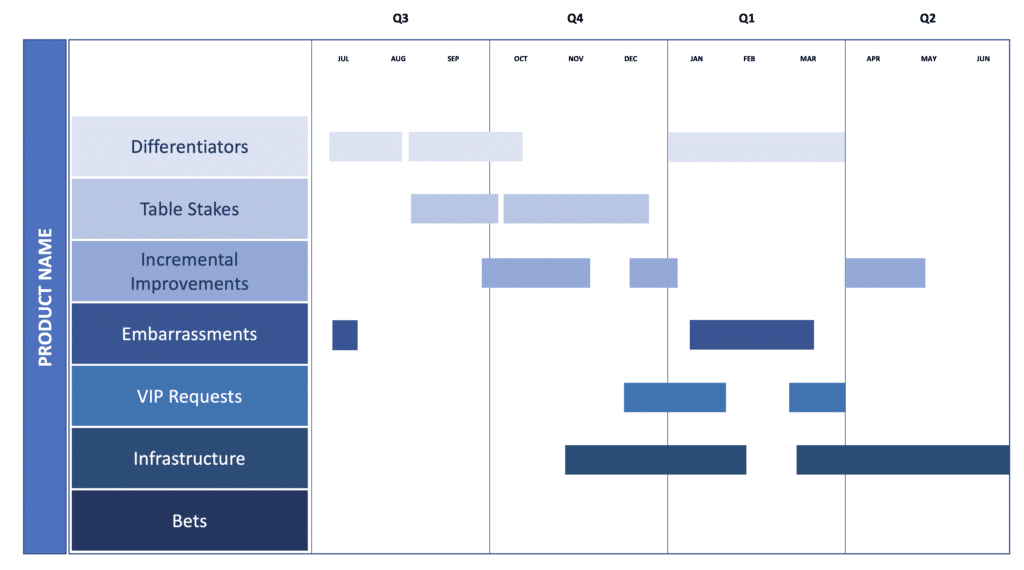Whether you create a product roadmap or not is immaterial
I know people who plan their products without anything written on paper. I know folks who use SaaS products, and others who use checklists. And these days the folks who do create plans often use roadmap themes instead of specific features to plan their work.
How you plan your work is immaterial. There's a bigger question…
What if those product roadmaps are incomplete? What if they're missing a theme?
What is a Product Roadmap Theme?
A product roadmap theme connects the business (and the business focus) with the product (and its features).
Let's say your developer comes to you and says, “Hey, there's a new JS framework that I want to use. I think I can build this cool chat feature for our product.”
You're left with a series of questions:
- Is that a good use of time?
- Is the tech really a good fit for us?
- Will that feature actually sell more units?
When you build a product – whether it's an online course, a membership site, a premium plugin, or something else – you expect to sell units. That's a no brainer.
But those questions make you think about the other dynamics, like opportunity cost (what if we used the time to do something else?).
Let's say your support person comes to you and says, “Hey, our customers are having trouble registering. Can we look at doing some sort of social login?”
You're back to similar questions:
- Is that a good use of time?
- Will the feature solve the problem?
- How much will it save us in support costs?
What you're doing is linking the feature idea back to the business dynamics.
Normally, if you were to talk more about either of these ideas, you'll likely come up with a key metric that this idea improves (unit volume, support costs, etc.).
And that's what a theme is: a connection between the business and planned / proposed features. And you group the feature ideas by the metric that it impacts.
What product roadmap themes are you already using?
I bet I can guess at least three roadmap themes you're already using.
You likely have a theme for differentiators. These are efforts that are meant to help you stand out from your competition. It might be a change in price, a new feature, or a different limit to use (user count, site count, etc).
You might measure success here via the growth of new customers.
You likely have a theme for improvements. These are efforts that are meant to make your product better at what it already does. This could be an enhancement to a feature, better documentation, or changing your help desk software.
You might measure success here via the reduction in customer churn / attrition.
And I'm guessing you also have a theme for infrastructure. These are efforts to change how you deliver your product (like hosting), the use of partner products, or even the architecture of your code (a refactor) so you can do more later.
You might measure success here via a reduction in your COGS.
Are you missing these four other themes?
I bet, when you think about the work that actually makes it to your product roadmap, there are other items placed on there that aren't in any of those previous roadmap themes.
You know, the stuff that gets added on because of politics, urgency, a call from the CEO, or some other reason.
- Table Stakes – These are efforts that you need to work on just to match what is happening in the rest of the space you compete in. Your competitors (almost all) already do these, and you need to add them to your product just so you don't look like the odd one out.
- Embarrassments – These are efforts where you need to fix something that is so limiting that your competitors can point to it (regularly) and eliminate you from the list of evaluated options. It's that thing you keep telling yourself that at some point you have to fix.
- VIP Requests – Have a VIP, special, or large customer who gives you feedback? A special request? You likely can't ignore it forever. So it's going to get on the roadmap at some point. You might as well create a space for it.
- Bets – These are strategic risks you're willing to make to open up new opportunities. You won't always have them on your roadmap, but they're worth thinking about. In McKinsey's Three Horizon model, it leads to horizon three.
Putting it all together
When you put it all together, you might end up with a roadmap that looks a bit like this one. It puts each theme into its own swim lane so that it's easy to talk about.

When you manage your product roadmap themes correctly, it will help you build your narrative directly into your product – making your marketing and sales a lot easier.
Sign up for free content. People still do that.
Thousands of folks (7000+) regularly get my posts in their inbox. For free.
